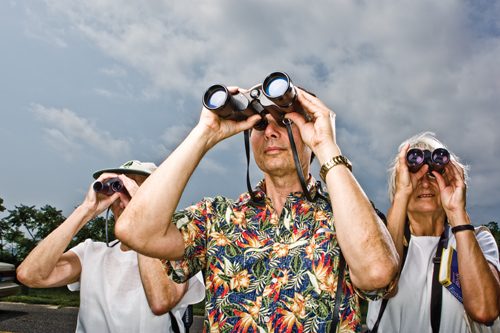
Ken Kavulia, 62
We kind of had a hard time that day. Not much variety—loads of shore sparrows that are not too spectacular. But we did see a cedar waxwing, a pretty impressive bird. It’s got a tufted head and a light-tan body, grayish wings, a brown head. Don’t take my word for the colors too much. I’m partially color-blind.
My wife’s sister was visiting us from Germany. She’s a bird-watcher, too, so we took her to some of the better areas along the Shore. We started in Allaire State Park that day, then went to Sandy Hook. Both are in Monmouth County. We decided to save Brigantine for another day. We try and get out once a month for bird-watching, just to see what’s new. It was a beautiful day, bright, clear skies. The temperature was very comfortable.
I’m a retired computer programmer, my wife was a biotechnician. She and I met in Iceland. She was returning home to Germany after working in Chapel Hill, North Carolina, at the university. I was visiting Europe for the first time. We both took Icelandic Airlines. At that time, Icelandic required that you stop over in Iceland on your way to Europe. So while I was there I took a tour, and she was on the bus, and we met. I would have been 28. She would have been 30. We didn’t see many birds. That was before I got interested in birds.
She gave me her address and said, ‘If you’re in Nuremberg, stop at my parents’ house.’ And I did. I met her parents there, and she showed me around Nuremberg. Then I continued on my journey. We exchanged letters after that and dated for a couple of years. She came here once. I went over there a few times. It got very expensive. We decided it was cheaper to get married than to continue dating.
I liked nature, but I had never had any experience with birds, growing up in Bayonne. When we moved down here—we live in Howell—we saw so much bird life in the backyard that we got a little guidebook and started trying to identify the ones that came around to our feeder. And we started visiting different parks around here. We would see some of the shore birds. Then we went down to Cape May and Brigantine, which are wonderful bird spots. It developed gradually.
There used to be more birds around, but a lot of development has taken place, so we don’t quite see all the species we did before. There was something called a pine siskin—it looks kind of like a small sparrow, but it has a little yellow under the wings. That was a nice bird. The most spectacular one was something called an evening grosbeak. It’s got a yellow breast, a yellow mask, and yellow on its back, black-and-white wings, a black tail, a black cap on its head. This is the male I’m describing. It’s a little more gaudy than the female. The first year we saw, I think, over twenty pairs of evening grosbeaks. After that there were less of them, and then perhaps five years later, in the early ‘80s—well, we haven’t seen any since then.



